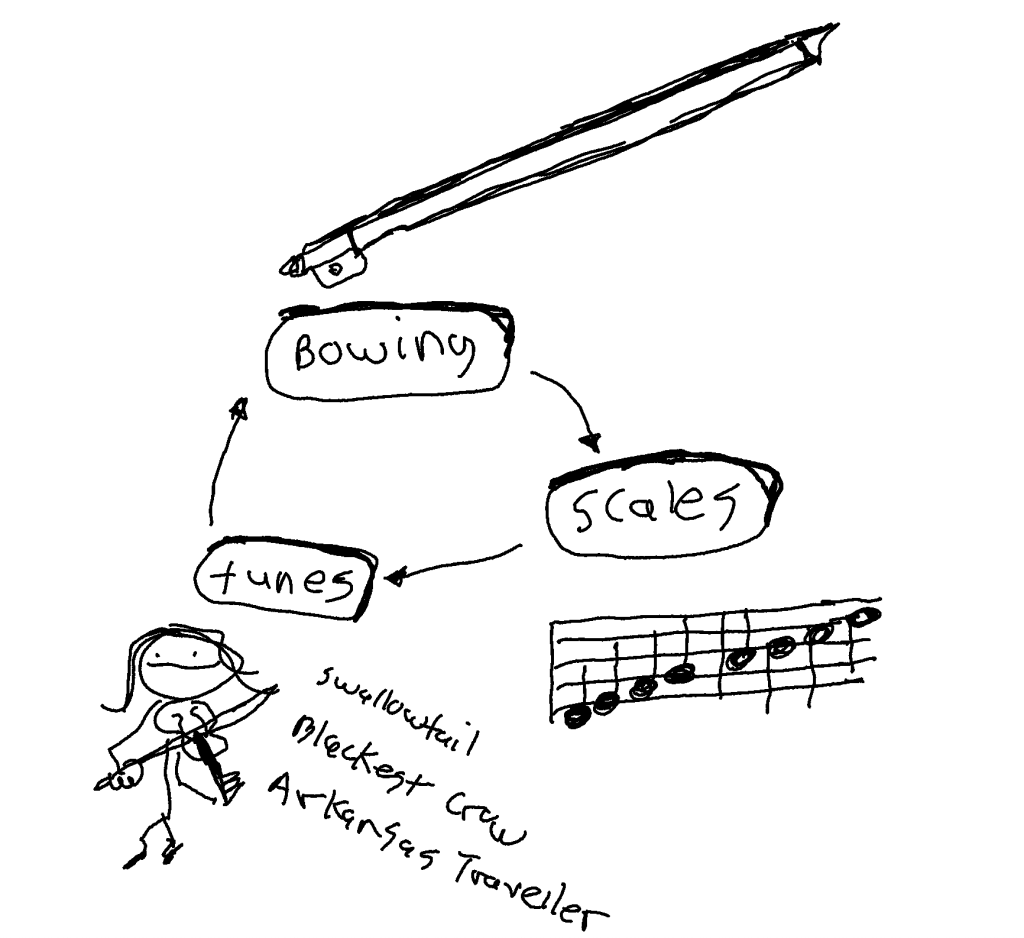Interleaving is alternating between different skills as you practice.
Instead of pounding away at a difficult scale for an entire session, a difficult bowing in another session, and then a hard tune in still another session, alternate between each skill multiple times in a single session.

If you find you’re getting extremely frustrated doing something like double stops, just pause on that for the time being and switch to practicing a different skill. Later in the practice, return to that difficult skill.
The spaced repetition of skills helps the brain to learn and remember them. Each time you practice the challenging thing you have a fresh approach. You’ll learn to find multiple solutions to the same problem.
Interleaving keeps you interested in what you’re doing. Go deep on something, then let it go for a bit. Each time you return to it it will be a little easier. You’ll gain confidence. Challenges will start to be fun.
In this way, Interleaving is a way to be kind to your body and yourself. Work at something hard for a bit, shift your attention before it becomes painful, then return to it. This is a key to make music practice more enjoyable.

A simple interleaving strategy would be to alternate between bowing, scales and tunes. Here’s a suggested approach:
- Before starting a session, decide on what bowing you want to practice, which scale you’ll practice and which tune.
- Practice each thing for five minutes. Take a minute to reflect on how it went.
- Then do it all again. For each activity, ask yourself,
- What has changed? Is it easier? If not, what can I do to practice what’s difficult? Can I slow it down?
I usually interleave a few different things in my own practice. For example:
- Scale: Melodic Scale Variation 1-2-3-1 on A Dorian
- Bowing: Orange Blossom Special
- Tune or song: Frosty Morning
You can strengthen the “Interleaving Effect” by doing this across multiple practice sessions. Take note of what you practice in a session. During the next session, cycle through the three things you just did in the previous session.
I take note of what I practice each day. Then review things that needed work. For things that need less work, I’ll leave a greater space before repeating it. For example, if I played frosty morning well yesterday and remembered it fine, then maybe I won’t come back to it for a week or two. If I play it well in two weeks, I might not review it for a few months. But if I have trouble remembering it then I might review it sooner, like in a few days.
Have you already been using this practice strategy? If not, try it out for a few weeks. Leave a comment below on how it goes.
Reference
Related posts
-
- Reflection
- If you take note of what you practice today, you can build on that tomorrow.
- How to track your practice
- What did you have for dinner last night?
- This is a fun memory technique similar to interleaving.
- I teach a memory technique called “Fingerprinting” in this lesson: How to remember fiddle tunes
- Reflection
Two ways I can help you level up your fiddling
- Sign up for the FiddleHed newsletter below.
- Sign up for the Free Two-week Trial. You’ll get full access to all courses and group lessons. Plus, I’ll send you some free lessons tailored to your current skill level.
Thanks for being here 🙏


So, I’ve been struggling with memorization/learning the tune. I want to be able to play without sheet music, or a guitarist leading the way lol. I realize during practice I’m so afraid that I won’t be able to get back to it because of life’s demands, so I play as much as I can, and focusing very little on keeping what I’ve played/practice.
One strategy that I’m trying is to take all the songs you use, download a version from Apple Tunes, and listen while I’m driving. If I listen to it a million times, maybe the tune will stick with me, and I’d have a better chance of playing it without sheet music. We’ll see! 😀